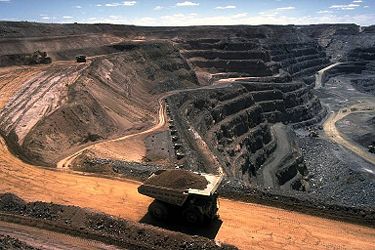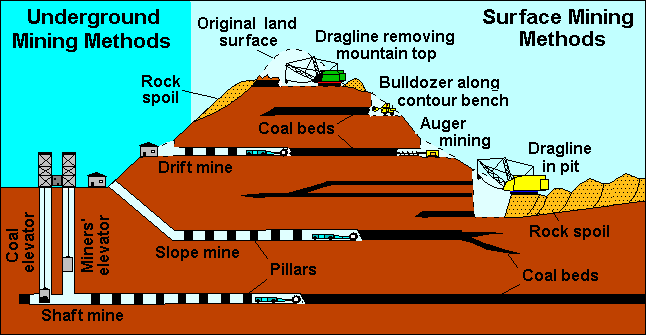Coal: Difference between revisions
imported>Milton Beychok m (→Coal mining: Replaced crude hand-drawn sketches with much better diagram from Kentucky Geological Survey.) |
imported>Milton Beychok m (Null space) |
||
| Line 6: | Line 6: | ||
Coal is primarily [[carbon]], with traces of [[sulfur]], [[oxygen]], [[hydrogen]], [[nitrogen]], and other elements.<ref>Needs a section on coal composition, coal ranking (classification) and typical assays.</ref> The processes of decomposition and lithification drive off most of the oxygen, hydrogen and nitrogen from the plant material, leaving primarily carbon. | Coal is primarily [[carbon]], with traces of [[sulfur]], [[oxygen]], [[hydrogen]], [[nitrogen]], and other elements.<ref>Needs a section on coal composition, coal ranking (classification) and typical assays.</ref> The processes of decomposition and lithification drive off most of the oxygen, hydrogen and nitrogen from the plant material, leaving primarily carbon. | ||
Due to its high carbon content and solid, easily-handled form, coal is used for fuel, and has been for hundreds of years (see [[Coal mining, history of|history of coal mining]]). Coal can be burned directly, or it can be converted to [[coke]] by [[destructive distillation]] (called [[Coke|coking]]), which alters the physical properties to provide a more uniform and more combustible product. Coke is used in making [[steel]] to provide heat and to add controlled amounts of carbon to the iron. | Due to its high carbon content and solid, easily-handled form, coal is used for fuel, and has been for hundreds of years (see [[Coal mining, history of|history of coal mining]]). Coal can be burned directly, or it can be converted to [[coke]] by [[destructive distillation]] (called [[Coke|coking]]), which alters the physical properties to provide a more uniform and more combustible product. Coke is used in making [[steel]] to provide heat and to add controlled amounts of carbon to the iron. | ||
==Coal reserves and production statistics== | ==Coal reserves and production statistics== | ||
Revision as of 13:32, 27 April 2009
Coal is a carbonaceous rock which occurs as a result of anaerobic decomposition of plant matter and lithification of the resulting material. Coal occurs in three main forms: anthracite, bituminous coal, and lignite, depending on the degree of lithification. Coal is primarily carbon, with traces of sulfur, oxygen, hydrogen, nitrogen, and other elements.[1] The processes of decomposition and lithification drive off most of the oxygen, hydrogen and nitrogen from the plant material, leaving primarily carbon.
Due to its high carbon content and solid, easily-handled form, coal is used for fuel, and has been for hundreds of years (see history of coal mining). Coal can be burned directly, or it can be converted to coke by destructive distillation (called coking), which alters the physical properties to provide a more uniform and more combustible product. Coke is used in making steel to provide heat and to add controlled amounts of carbon to the iron.
Coal reserves and production statistics
Economically recoverable coal deposits exist in more than 70 nations and in every major region of the world (Africa, Asia, Australia, Europe, North America and South America). It has been estimated that the worldwide proven reserves of coal amounted to about 848 gigatonnes (Gt) as of 2007.[2] Proven coal reserves are those coal deposits that have been confirmed by exploration, drilling and other means, and which are economically and technically extractable.
It has also been estimated that the worldwide production (i.e., mining) of coal amounted to about 5543 megatonnes (Mt) as of 2007.[3] If that rate of production remains constant, the proven reserves will last about 150 years.[2]
The tables below list the distribution of coal reserves and coal production nation-by-nation as of 2007:
|
|
Economic use
Industrial Revolution
The large-scale exploitation of coal was an important moving force behind the Industrial Revolution. Coal was used in making iron and steel. It was also used to power the early railroad locomotives and steamboats, driven by coal-burning steam engines, which made possible the transport of very of large quantities of raw materials and manufactured goods. Coal-burning steam engines also powered many types of factory machinery.
The largest economic impacts of exploiting coal during the Industrial Revolution were experienced in Wales and the Midlands of England, and in the Rhine and Ruhr river areas of Germany. The early railroads also played a major role in the westward expansion of the United States during the 19th century.[4]
United States
Currently, burning of coal provides about one-quarter of the electric power of the United States, and accounts for about one-quarter of energy use worldwide. About 90% of coal mined in the United States is burned to produce electricity.[5]
China
Coal produces over 80% of China's energy; 2.3 billion metric tons of coal were mined in 2007. Despite the health risks posed by severe air pollution in cities (see Beijing) and international pressure to reduce greenhouse emissions, China’s coal consumption is projected to increase in line with its rapid economic growth. Most of the coal is mined in the western provinces of Shaanxi and Shanxi and the northwestern region of Inner Mongolia. However most coal customers are located in the industrialized southeastern and central coastal provinces, so coal must be hauled long distances on China’s vast but overextended rail network. More than 40% of rail capacity is devoted to moving coal, and the country has been investing heavily in new lines and cargo-handling facilities in an attempt to keep up with demand. Despite these efforts, China has suffered persistent power shortages in industrial centers for more than five years as electricity output failed to meet demand from a booming economy. Demand for electricity increased 14% in 2007. Severe snowstorms in late January 2008 seriously disrupted the rail and electrical systems, at a time when some 200 million city workers were attempting to visit their home villages during the Lunar New Year holiday.[6]
Coal mining
Coal tends to exist in seams, which are lateral layers under the earth which may vary in height from 1 or 2 feet to dozens of feet. Mining of coal seams is achieved in several different ways. "Strip" mines scrape coal from the earth's surface; they may be large open pits, or if on a mountain, result in ribbons chewed away from around the perimeter of a mountain at each level where a seam of coal exists. So-called "drift" mines angle horizontally into a mountainside and may be very shallow (i.e., not tall enough for a person to stand up in). "Shaft" mines, also called deep mines, reach down vertically to open into person-sized horizontal tunnels which may be miles from the surface.
Strip mines remove any top soil with bulldozers to get at coal near the earth's surface. Coal is excavated from the ground in what becomes large pits, or else ribbons of stripped land stretch around a mountain. After strip mining has exhausted the available surface coal, the mining company often abandons the site with no restoration, leading to severe erosion problems (with resultant flooding or pollution) and to an unsightly landscape that cannot support plant growth due to the lack of topsoil. Drift mines may be used after strip mining has used up surface coal. Because drift mines tend to be shallow, special equipment may be required to mine them, on which, for example, workers can lie flat on short vehicles moving inside the tunnel. Drift mining is common in the extreme southwest corner of Virginia. Deep mines are similar to those for any other mineral deposit found deep enough in the earth that the cost of removing the overburden is prohibitive. Shafts are dug and veins of coal are excavated and transported to the surface.[7]
Deep and drift mining safety
Early mining methods led to very unsafe mines which often were not even represented on maps at all, or were represented inaccurately.[8] Early mining methods led to irregularly spaced supporting pillars, which often were not represented on maps, or were represented inaccurately. Modern mines have regular pillars at safe intervals of known thickness.
Even using the best known methods, underground coal mining is hazardous work. In addition to the hazard of simple cave-ins, miners have to worry about their tunnels flooding, accumulation of "bad air" (gases lacking enough oxygen), accumulation of explosive gases resulting in fires and/or cave-ins, and many other unexpected problems. Bad air and water can suddenly flood a tunnel if a pocket of the non-oxygenated gas or water is reached without warning when removing coal from a seam.
Following known best practices can reduce the likelihood of extensive loss of life during catastrophic mining accidents. Poor safety records of some mine owners led to the formation of labor unions around the world, and today there remains a high degree of solidarity among mine workers. Mining deaths still occur periodically that arguably could have been prevented with appropriate safety equipment, training and safety procedures.
Notes
- ↑ Needs a section on coal composition, coal ranking (classification) and typical assays.
- ↑ 2.0 2.1 2.2 2007 Survey of Energy Resources World Energy Council 2007
- ↑ 3.0 3.1 Coal Facts 2008 Edition (with 2007 data>
- ↑ Railroad history in the United States
- ↑ Needs to be fleshed out with more accurate statistics, and some references
- ↑ David Lague, "Chinese Blizzards Reveal Rail Limits," New York Times Feb. 1, 2008
- ↑ Needs more discussion
- ↑ Children in coal-mining areas sometimes can't resist entering old mines, which can be especially dangerous.


